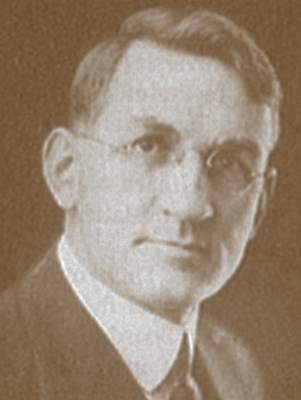Richard R. Lyman
Born November 23, 1870 in Fillmore, Utah, Richard Roswell Lyman inherited a rich legacy of of religious service from prominent members of The Church of Jesus Christ of Latter-day Saints. His father and grandfather were both members of the Quorum of the Twelve Apostles; his father was President of that Quorum for 13 years. Richard’s mother was the only sister of George Albert Smith, who was a cousin of the Prophet Joseph Smith and a counselor to President Brigham Young. His great-grandfather, John Smith, was a Patriarch of the Church prior to his death.
As a young boy, Richard rarely smiled or laughed. At the age of seven, Richard moved with his family to Tooele, Utah, when his father was called to preside over the stake there. He was a good student, although he found issue when studying geography because he faced south instead of north in the classroom. He maintained that all students of geography ought to be sitting facing north. At age 12, Richard was sent to Provo to study at Brigham Young Academy. Following that, he attended Brigham Young College in Logan. He then left to attend school in the East at the University of Ann Arbor. He reached an agreement with his father that he would pay the tuition while Richard was in school, but that Richard would pay him back at a 10% interest rate. Richard did so over a period of seven years.
Richard worked hard at the University, focusing on mathematics, but also studying literature, history and chemistry. He was elected class president his sophomore and senior years. Academics were a very important part of his life, and he was a teacher for over 25 years. From 1896 to 1918, Richard served at the University of Utah beginning in the fall of 1896 and continuing until the spring of 1918, Richard R. Lyman, at the University of Utah, passed through all the grades of instructor, assistant professor, associate professor and full professor in charge of the department of civil engineering. He held a full professorship and was head of the department for eighteen years. He spent the summer of 1902 with his family doing advanced work in the University of Chicago. He also spent time at Cornell University where he was given a residence credit of three years. While there, with the class of 1903, he was graduated with the degree of M. C. E. (Master of Civil Engineering).
In the spring of 1904 he was elected by the faculty of Cornell University to membership in the society of The Sigma Xi, a scientific organization into which only those who have achieved marked success and have unusual ability in the line of scientific investigation and research are supposed to be received. With the class of 1905 he was graduated with the degree of Ph. D. (Doctor of Philosophy). In one year he was awarded the only scholarship offered by the college of civil engineering, and during another, the only fellowship offered by that same department. In addition to teaching, Richard wrote and had published several academic articles.
Richard was put in charge of maintaining care of his father’s team of horses and buggy and often was the driver for his father and then Heber J. Grant, who followed his father as President of the Tooele Stake, as they traveled on church business.
His father was a firm believer that young boys should be taught early how to work and how to work hard. Like his father, Richard kept a daily journal and recorded the frequency with which he attended his church meetings. His mother impressed upon him the importance of reading and following the scriptures. She gave him a copy of the New Testament which Richard carried with him often.
After eight years of courtship, Richard married Amy Brown in 1896. He credited any achievement he made in work, church or social life to her. They had two children; a boy, Wendell, and a girl, Margaret.
In 1918, Richard was called and sustained as a member of the Quorum of the Twelve Apostles. Richard served long and worked very hard, both in the Church and academics. However, in 1943, he was excommunicated as a result of personal reasons. He was re-baptized in 1954, and remained faithful until his passing on December 31, 1963, at the age of 93 in Salt Lake City, Utah.
